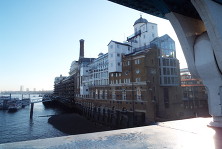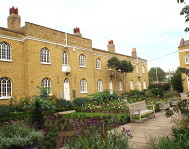








Watch-houses: St Mary Magdalen, Bermondsey
St John's Horsleydown, Bermondsey
St Mary's, Rotherhithe
Top: the watch-house attached to St Mary Magdalen, Bermondsey Street. Middle: the watch-house attached to St Mary's, Rotherhithe in St Mary Church Street. Bottom: the watch-house attached to the former church of St John's Horsleydown, Bermondsey
Before the formation of the Metropolitan Police in 1829, policing duties were undertaken by a local body known as the watch that was organised by the parish vestry. Until the end of the 17th century, the watch consisted of householders within the parish who patrolled the streets on rotation from about 9pm to sunrise, examining suspicious characters they encountered and apprehending felons suspected of burglary and crimes of violence. This was not without danger to members of the watch and increasingly householders paid deputies to take their place, the first steps towards a professional police force. The watch was supervised by a constable. Originally a member of the local parish this post was also increasingly undertaken by someone hired for the role. Further information regarding the history of the policing of London can be found here.
Members of the watch reported for duty at the parish watch-house, an embryonic police station of sorts, where apprehended criminals were kept for the night before being brought before the magistrate in the morning. Usually built adjacent to the parish church burial ground, the watch-house also provided a means of guarding graves from body-snatchers. Known as the Resurrection Men, body-snatchers dug up the corpses of the recently buried to sell to the local hospitals of St Thomas’s and Guy’s for the purpose of teaching anatomy. Legally the medical profession were only allowed to use the bodies of those who had been executed but as the death sentence was carried out less frequently towards the end of the 18th century, there was a shortage of cadavers. The passing of the Anatomy Act in 1832 ended this gruesome practice.
I have been able to locate three surviving watch-houses in Southwark, all Grade II listed. The watch-house situated on the corner of the former burial grounds at St Mary Magdalen in Bermondsey Street was built in the early 19th century and survives today as a café.
Another is located at the entrance to the former burial ground of St Mary’s Rotherhithe and was built in 1821. Now also a cafe, it formed a pair of buildings with the engine house built at the same time at the other side of the entrance. An earlier watch-house had been located in St Mary’s Passage (now a part of Rotherhithe Street to the north of the church) close to where the stocks were located.
The third watch house, built in the 18th century, is the largest and oldest of the three and located in the former burial grounds of the St John’s Horsleydown, Bermondsey. The church closed in 1968 and the site purchased by the London City Mission. Today the watch house shows signs of occupation and is railed off from the former burial ground, now a public park.
Web discoveries
- UK Casino Not On Gamstop
- UK Casino Not On Gamstop
- Non Gamstop Casino
- Casinos Not On Gamstop
- Non Gamstop Casinos
- Non Gamstop Casinos
- Non Gamstop Casino
- Casino Sites Not On Gamstop
- Slots Not On Gamstop
- Casinos Not On Gamstop
- UK Betting Sites Not On Gamstop
- UK Casino Not On Gamstop
- Best Non Gamstop Casinos
- Betting Sites
- Non Gamstop Casino Sites UK
- Best Non Gamstop Casinos
- Non Gamstop Casino
- Casinos Not On Gamstop
- Non Gamstop Casino Sites UK